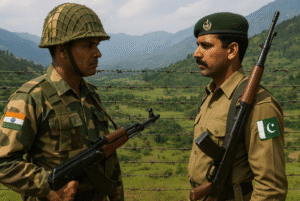Kashmir Crisis: 7 Shocking Truths Behind India-Pakistan Tensions That Could Ignite War
A deadly terror attack in Kashmir has reignited tensions between nuclear-armed rivals India and Pakistan, pushing them toward their most perilous standoff in years. India’s suspension of the 1960 Indus Waters Treaty—punishing Pakistan by threatening its water security—marks a dangerous escalation in a conflict rooted in decades of territorial disputes, cross-border militancy, and competing national identities. Historical grievances, from Partition in 1947 to India’s 2019 revocation of Kashmir’s autonomy, fuel mutual distrust.
Both nations now face internal turmoil: Pakistan grapples with political chaos and economic collapse, while India’s Hindu nationalist agenda risks inflaming domestic divisions. Though nuclear deterrence has historically prevented all-out war, miscalculation remains a dire threat. Civilian suffering in Kashmir, silenced in geopolitical posturing, underscores the human cost of prolonged conflict. De-escalation hinges on discreet diplomacy, restored communication channels, and third-party mediation, but leadership must prioritize pragmatism over pride.
The world watches as two nations, burdened by legacy and survival, confront a choice between catastrophic conflict and the courage to compromise.

Kashmir Crisis: 7 Shocking Truths Behind India-Pakistan Tensions That Could Ignite War
The recent terror attack in Kashmir, claiming 26 lives—mostly Indian tourists—has reignited one of the world’s most volatile flashpoints. With India accusing Pakistan of cross-border terrorism and retaliating by suspending the Indus Waters Treaty, the two nuclear-armed neighbors stand closer to conflict than at any time since the 2019 Balakot airstrikes. As troops mobilize and rhetoric intensifies, the urgent question looms: Can diplomacy prevail over disaster?
Roots of the Rivalry: Kashmir’s Unending Strife
The Kashmir conflict, born from the trauma of Partition in 1947, remains a festering wound. India’s revocation of Jammu and Kashmir’s autonomy in 2019 under Prime Minister Narendra Modi’s Hindu nationalist agenda deepened distrust. Pakistan, positioning itself as a defender of Kashmiri Muslim rights, rejects India’s claims of progress in the region, citing widespread allegations of human rights abuses, internet blackouts, and demographic shifts.
This cycle of blame is not new. Cross-border militancy, such as the 2001 Parliament attack and the 2019 Pulwama bombing, has repeatedly brought the nations to the edge. Yet, nuclear deterrence has historically acted as a grim safeguard. The 1999 Kargil War and 2001–2002 military standoff saw both sides retreat, aware of mutual annihilation’s specter.
Domestic Turmoil: Weakness Breeds Brinkmanship
Both nations face internal crises that paradoxically heighten war risks.
- Pakistan’s Fragility: Economic collapse, political chaos since Imran Khan’s ouster, and resurgent Taliban threats have left its military-ISI complex as the lone stabilizing force. A conflict could rally nationalist sentiment but risk existential devastation.
- India’s Divides: Modi’s BJP, eyeing 2024 elections, may leverage anti-Pakistan fervor to distract from rising inequality and Hindu-Muslim tensions. Yet, war could destabilize India’s economic ambitions and global credibility.
Water Wars: The Indus Treaty’s Dangerous Suspension
India’s decision to halt the 1960 Indus Waters Treaty—a rare diplomatic success—escalates tensions beyond military posturing. Pakistan relies on the Indus for 80% of its agriculture; even symbolic cuts could devastate its food security. However, experts note India lacks infrastructure to immediately redirect river flows, suggesting the move is a political gambit. Pakistan may retaliate through international arbitration or support proxy groups, further entangling the crisis.
The Nuclear Shadow and Silent Diplomacy
While nuclear weapons deter all-out war, they also enable risky brinkmanship. Both nations have expanded arsenals since their 1998 tests, with India adopting a “No First Use” policy and Pakistan refusing to, citing conventional inferiority. Yet, as former Pakistani diplomat Maleeha Lodhi warns, “Miscalculation, not intent, is the real threat.”
Behind the scenes, third-party mediation may be critical. The UAE brokered a 2021 ceasefire, and Qatar recently facilitated U.S.-Taliban talks. China, a Pakistani ally with economic stakes in India, could play a dual role, while the U.S. prioritizes regional stability to counterbalance China. However, Modi’s “strategic autonomy” doctrine and Pakistan’s reliance on China complicate multilateral efforts.
Kashmir’s Human Cost: The Forgotten Narrative
Amid geopolitical maneuvering, Kashmiris endure daily violence, militarization, and silenced voices. Civilian casualties, arbitrary detentions, and psychosocial trauma define life in the valley. “Both nations weaponize our suffering,” notes Kashmiri activist Ather Zia. “Peace cannot come without addressing our right to self-determination.”
Pathways to De-escalation
- Track II Diplomacy: Backchannel talks, like those that averted 2001 war, could resume. Neutral nations like Switzerland or Norway might host discreet dialogues.
- Reinstate Communication: Restoring diplomatic ties and hotlines, severed since 2019, could reduce miscalculations during clashes.
- Economic Incentives: Reviving trade (halted since 2019) or offering aid could build goodwill. The China-Pakistan Economic Corridor’s expansion might incentivize Pakistani restraint.
- Third-Party Monitoring: UN observers or neutral monitors along the Line of Control could verify terror claims and reduce false-flag risks.
Conclusion: A Choice Between Legacy and Survival
History shows India and Pakistan can step back from the abyss—but only with sober recognition that war offers no winners. Modi’s legacy-driven politics and Pakistan’s military calculus must yield to pragmatism. As climate disasters and economic inequities grow, both nations’ futures hinge not on territorial conquest, but on collaborative survival. The world watches, hoping leaders prioritize humanity over hubris.
- Lessons from History: The 2019 Balakot crisis saw India’s limited airstrike and Pakistan’s return of a captured pilot, underscoring the value of face-saving exits.
- Water as a Weapon: Analysts suggest India’s treaty suspension mirrors Ethiopia’s Nile dam disputes, using resource control as geopolitical leverage.
- Youth Demographics: With 60% of Kashmiris under 30, prolonged alienation risks radicalization, fueling cycles of violence.
In the end, the crisis is a test of leadership—one where courage to compromise may save millions from catastrophe.
You must be logged in to post a comment.